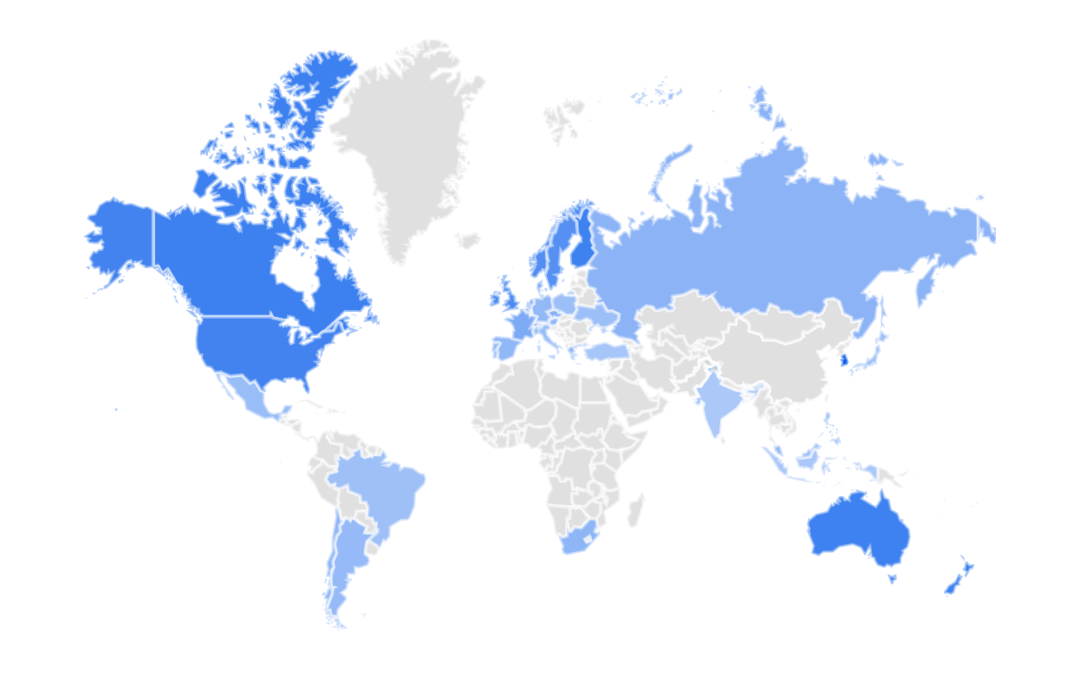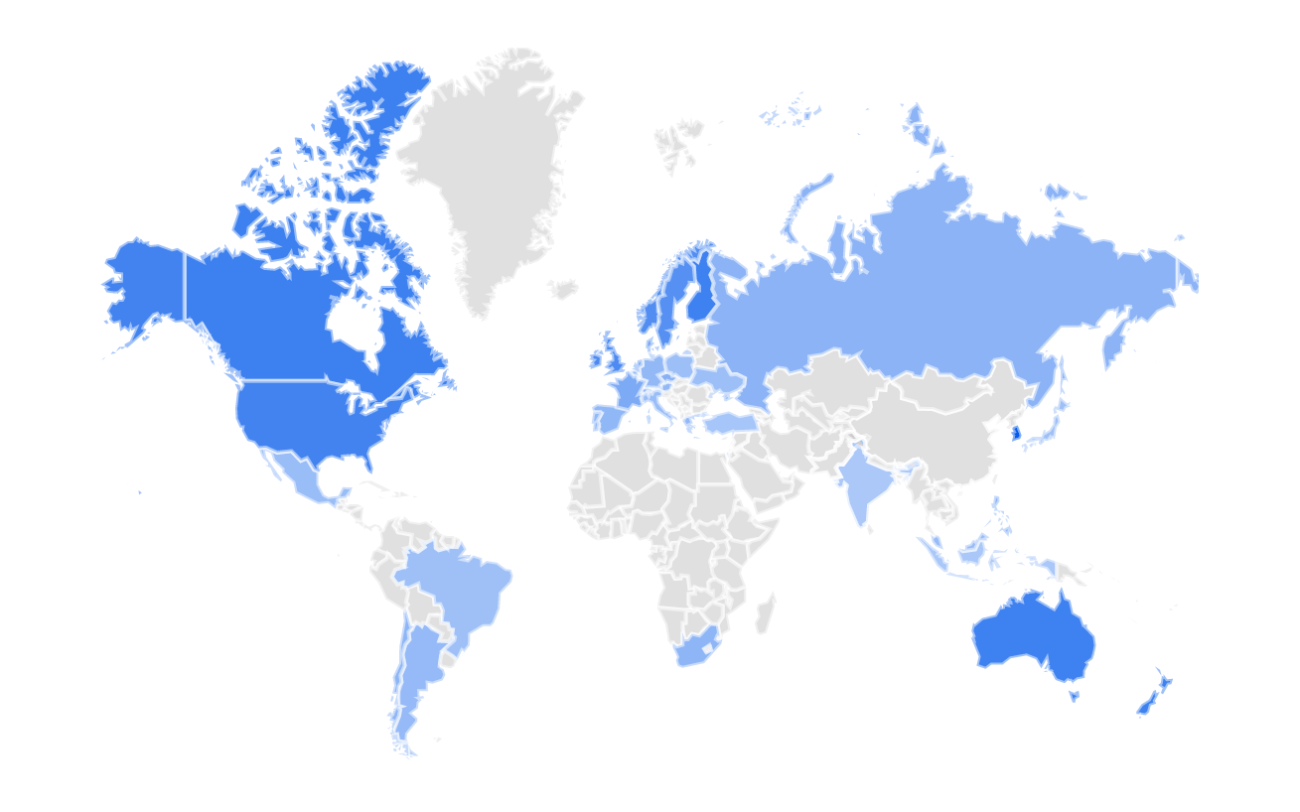
How A.S.M.R. Became a Sensation
Interest in A.S.M.R by region
I am not an avid YouTuber, which leaves me fraught with conflict about why I haven’t taken advantage of it. Because there’s money to be made out there with material as written about here, that honestly, I find dumbfounding. But, no more dumbfounding than a million other sites, and postings that are just as puzzling.
Having spent so many years in advertising, sales and marketing, I have an instinctive belief to how these things seed, grow, and take shape for popular consumption. As always, as it was then, that is entirely what the money goal is about. Its not so much about memberships, or paid views. its about advertising revenue. Eyes, Minds, Pocketbooks, Wallets, and today, selling off your privacy as well.
Considering the demographic of most hyper active Youtuber viewers (not producers), I woudl venture to guess, they have either no clue about how much they give up of their privacy, or they just don’t care, waving it off as part of their life culture, as if its some type of generational badge of their moment in time. Sort of like saying, “we can’t beat’em, so lets join’em, stop being suspicious and paranoid, and assume the best for our interests is in the hands of every advertiser, and exploitative entity that has our info. Its rosy, but naiive to the nth degree.
The story below on A.S.M.R reflects one of many more similar stories in our current technoculture. I read it in full, decided it was a fad, an opportunity to make money based on the strange traction things of little importance can pick up today. But, as often happens after reading articles and reporting of quality depth and observation, I came away with two paragraphs that stuck with me, and made the whole effort worthwhile.
They are highlighted below, they are my takeaway:
Intimacy is a human need, but the ways we fulfill it are historically contingent. Of course there are explicit means like friendship and sex, but we also have all kinds of rituals that provide human connection as a second-order perk. When I go to the hair salon, I am there to get my hair cut, but that doesn’t mean that I don’t like the attention. When I listen to a podcast, I enjoy the information, but I can’t deny that I also like the sound of friends inside my house. Lots of things in everyday life throw off incidental rays of affirmation. Often, these second-order perks are so ingrained in first-order activities that we do not think to express them as desires. You might enjoy having your feet touched, but you don’t go to the shoe store just for fun. Our culture has names for people who do — freaks, kooks, eccentrics, even perverts.
When is something sexual? Somehow, we Americans have spent decades debating sexual gray areas without sufficient language to describe the different shades. Is a back massage sexual? What about texts from a married man? Is it sexual to lie on the floor of a yoga studio with 20 total strangers? To show someone your penis in a comedy club? To let a tailor measure your inseam? To enjoy it? A lot of times, when we talk about sex, what we mean to discuss is all the stuff around it — loneliness, passion, intimacy, connectedness, power or lack thereof.
(If online link is restricted to subscribers, full text is pasted below.) Also, some YouTube samples are included below.
How A.S.M.R. Became a Sensation
The brain-tingling feeling was a hard-to-describe psychological oddity. Until, suddenly, it was a YouTube phenomenon.
Via NYTimes Magazine, By Jamie Lauren Keiles
April 2019
When Jennifer Allen watched videos of space, she sometimes felt this peculiar sensation: a tingling that spread through her scalp as the camera pulled back to show the marble of the earth. It came in a wave, like a warm effervescence, making its way down the length of her spine and leaving behind a sense of gratitude and wholeness. Allen loved this feeling, but she didn’t know what caused it. It was totally distinct from anything she’d experienced before. Every two years or so she’d take to Google. She tried searching things like “tingling head and spine” or “brain orgasm.” For nine years, the search didn’t turn up anything.
Then, around 2009, it did. As always, Allen typed her phrases into Google, but this time she got a result on a message board called SteadyHealth. The post was titled WEIRD SENSATION FEELS GOOD:
i get this sensation sometimes. theres no real trigger for it. it just happens randomly. its been happening since i was a kid and i’m 21 now. some examples of what it seems has caused it to happen before are as a child while watching a puppet show and when i was being read a story to. as a teenager when a classmate did me a favor and when a friend drew on the palm of my hand with markers. sometimes it happens for no reason at all
The poster went on to demand an explanation. In the discussion, nobody had one, but many described a similar feeling — a “silvery sparkle” inside the head, a euphoric “brain-gasm” or a feeling like goose bumps in the scalp that faded “in and out in waves of heightened intensity.” Many people agreed that the sensation was euphoric. (“Aside from an actual orgasm, it’s probably the most enjoyable sensation possible,” one user wrote.) Its triggers were as varied as watching someone fill out a form, listening to whispering sounds or seeing Bob Ross paint landscapes on TV.
Allen scrolled through pages and pages of discussion.
Oh my gosh, she remembers thinking. These people are talking about exactly what I experience.
In time, that post begot a second post: WEIRD SENSATION FEELS GOOD – PART 2. As discourse on the unnamed feeling evolved, users shared accidental triggers found online — a man unlocking a damaged padlock, someone brushing her hair. These videos had a gentleness in common that many of the users found hard to describe. Some spoke of the need for a research group to better understand the sensation. Still others expressed fear over social repercussions: Were they perverts? Were they sick? Were they indigo children? Pleasure is rarely consequence-free.
“People had been told they were on drugs or that they had lice — things like that,” Allen says. “And then there was the factor of people calling it a ‘brain orgasm’ and it sounding like some sort of erotic fetish kind of thing.”
Allen had invested a lot in the discussion, even expressing interest in the fledgling research effort. She saw how the feeling had improved her sense of calm, but she worried that the subtext of a “tingling sensation” would hold the group back from legitimacy. The whole thing sounded too hokey — or too horny. If they wanted to generate scientific interest, they needed a more scientific-sounding name.
And so in February 2010, she sat down to brainstorm some ideas. Others had tried to describe the weird sensation, but spacey nicknames like “attention-induced head orgasm” had never quite caught on. Allen felt a debt to the feeling’s New Age fans, but she also saw the usefulness of more clinical language. When no existing term could meet both conditions, she made up a new one: Autonomous Sensory Meridian Response, or A.S.M.R. She started with “autonomous” because it was a feeling from within; “sensory” was self-explanatory. “Meridian” worked triple duty, suggesting peak but also orgasm and the energy pathways of traditional Chinese medicine. “Response” was just to say that it was not a constant state; it happened in reaction to a set of stimuli, like whispering, gum chewing and tapping.
“I wish I’d made it a little shorter,” Allen says. But at least it sounded better than “brain-gasm.”
She debuted the new name on the SteadyHealth board by announcing the “ASMR Group” she had registered on Facebook. Discussion-board users migrated en masse, and soon membership spanned six continents: a blogger in South Africa, an artist in Detroit, an ethnobotany researcher working in Australia. They started sharing links to videos again — not the accidental triggers of before but a new genre created for the express purpose of inducing A.S.M.R. These videos often featured anonymous women delivering soft-spoken voice-over narration. According to message-board lore, the first of this type was a video titled “Whisper 1 – hello!” It was posted in 2009 but languished in the algorithmic scrap heap of YouTube on account of its weak, unsearchable title. Now, under the search-engine-friendly banner of A.S.M.R., this new genre offered an on-demand way to trigger the once-serendipitous sensation. A new crop of YouTube creators emerged to serve up the feeling to those who knew they felt it — at that point, a small but growing subset of the public.
Around the time when Allen found SteadyHealth, there were, by one count, 12 whispering channels on YouTube; three years later, that number had more than tripled. Soon a hard-won Wikipedia page would further extend the reach of the term — and further enshrine the new video genre. By 2015, the ASMR Group had made itself irrelevant. When Allen set out to name the weird sensation, she thought she was simply describing what she felt. She couldn’t foresee that her term would enable a whole new form of entertainment — or possibly something that transcended entertainment — born of the kismet of algorithmic fate as it brushed up against the crossed wires of the brain.
Today the action of A.S.M.R. plays out almost exclusively on YouTube, where legions of (mostly female) creators release, by my count, around 500 new videos each day. Over the course of reporting this article, I spent at least 200 hours on the site, watching women chew gum, swallow octopus sashimi, simulate eye exams, turn pages of books and peel dried glue off artificial ears. I watched a teenage girl role-play as a 14th-century nun, treating me for the bubonic plague. I watched a two-hour recording of hair-dryer sounds.
In the A.S.M.R. scene, new trends evolve quickly, driven by the spirit of innovation, corporate product-placement deals and a process of human-algorithm interaction that pushes the best new material to the top. Any trigger that starts to find fans is endlessly taken up and reperformed — ripped off by different channels for ad dollars — at least until the next trigger takes its spot. One month, cranial nerve exams are in. The next month, creators are all shaving bars of soap, chewing bricks of raw honeycomb or eating buckets of KFC. The feeling that fuels this growth is little understood, like the dark energy pushing our universe outward.
The internet is vast, but it brings like minds together. At its best, it serves to unite kinky freaks, dissidents of oppressive regimes and sufferers of obscure diseases. At the same time, this tendency can serve the cruel or misinformed — giving shared language to Nazis and incels and other bleak dopes who were once kept mercifully isolated from one another. This feature of the internet is, at best, value-neutral; in any case, A.S.M.R. tests its limits. The YouTube subculture is bonded not by belief but rather by an ineffable sensation — perhaps the first time the internet has revealed the existence of a new feeling.
Thinkers since ancient Greece, if not before, have found themselves obsessed with the true nature of the senses; even modern philosophers get tripped up discussing qualia, the irreducible stuff of consciousness. Subjectivity is hard to isolate, by definition, and examples of new metaphysical sensations are not exactly a regular occurrence. Synesthesia, often experienced as associating numbers with colors, is one of the rare examples. Though individuals since at least the 19th century have reported tasting words, seeing sound or hearing colors, it took until the 1980s for scientists to prove that the shared experience actually correlated with real, observable activity in the brain.
Thanks to the internet, A.S.M.R. seems to have leapfrogged the science entirely. Like synesthesia, it was first discovered by way of individual reports. Unlike synesthesia, it has not depended on brain imaging for cultural acceptance. Our foremost “proof” of A.S.M.R. comes from some people searching for the term and others making videos to populate those searches. All these YouTube users may be right that the feeling is real, but the scientific research still lags far behind.
Craig Richard, a professor of physiology at Shenandoah University in Virginia, first heard the term in 2013, on a podcast. “I’m listening to the beginning of this episode thinking, ‘This is a bunch of woo-woo bunk!’ ” he told me. Just as he went to turn the podcast off, the subject changed to the painter Bob Ross — by then, a well known A.S.M.R. trigger. Richard’s eyes lit up. In childhood, he spent afternoons watching Ross paint landscapes on TV. He remembered caring more about the painter than the painting. “It was his demeanor. It was the sounds he made and the way he talked — the way he looked in the camera.”
When the episode was over, Richard went to his computer to look up the research on A.S.M.R. At that point, he found nothing academic — only websites and forums that led him to the Facebook group. He reached out to Allen, and in collaboration with a graduate student and member of the community named Karissa Burnett, they conducted an informal online survey that, over time, has received more than 25,000 voluntary responses. (Where do you feel tingles? Head, neck, arm? Do you feel relaxed? Do you feel aroused?) Richard also started ASMR University, an online archive that today remains a useful clearinghouse of research on the topic.
Still, scientific understanding has moved slowly. Funding for A.S.M.R. research is hard to justify, and the diverse nature of A.S.M.R. triggers can lead to “noisy” data. To date, ASMR University lists just 10 peer-reviewed papers. More than half of these were published in author-pay journals. The most rigorous studies use f.M.R.I. to map the activity of blood flow in the brain as participants report feeling the tingles. Outcomes have suggested, in very small samples, that A.S.M.R. might have something to do with socially bonding “affiliative behaviors,” known to release feel-good hormones like oxytocin.
Richard, for his part, considers these outcomes from an evolutionary-biology perspective. He believes that the tingles of A.S.M.R. are meant to assist in reproduction and survival, and points out that triggers like grooming, whispering and eye gazing all bear strong resemblance to the ways that humans soothe infants. In adulthood, a range of similar behaviors contribute to intimacy between mates. This may be the case, but our current understanding still leaves behind more questions than answers: If A.S.M.R. plays (or played) a key survival role, why does it seem that only some people can feel it? Why should it come to our attention only now?
It does not seem very likely that the pace and scope of research will ever catch up to the cycle of new content. For now, our chief authorities on A.S.M.R. are women and girls, alone at their computers, manipulating objects for a faceless, growing public.
Around the time that “Whisper 1 – hello!” was picking up speed in Allen’s Facebook group, Gibi — today one of YouTube’s top “A.S.M.R.tists” — was a sophomore in high school. (I’ve withheld her last name here for below-explained reasons.) Like many teenagers these days, she often had trouble falling asleep. Sometimes she would sneak her phone into her room and watch YouTube videos to relax her mind. This habit evolved by a haphazard process, led by the whims of an infinite sidebar. Makeup tutorials segued to massage, which soon gave way to A.S.M.R.
Since that fateful discovery, Gibi has watched A.S.M.R. videos every single night. The ritual followed her off to college, where the videos became a kind of white noise while she studied. A.S.M.R. was, by that point, not just for those who experienced the tingles. The genre had begun to find broader appeal as a sleep aid, an alternative to guided meditation and a drug-free, online version of Xanax. The medium had developed its own microstars, women with handles like Gentle Whispering ASMR and ASMRrequests, who filmed themselves crinkling paper, tapping their nails on large wooden bowls, dealing cards, brushing hair and pouring cold milk into bowls of Cocoa Krispies. One of Gibi’s favorites, Heather Feather ASMR, went beyond mere sound effects, performing full-scale role-play scenes infused with attentive, deliberate sound. In one, Heather administered a colorblindness test, tapping her wand on a laminated chart. In another, she played as a tattoo artist, trying on a pair of purple nitrile gloves. Watching Heather’s videos made Gibi feel as if her “brain was swimming, in a good way.” She played the same scenes over on repeat, returning to parts that gave her the tingles.
At that point, in June 2016, many A.S.M.R.tists treated YouTube like a hobby. Across channels, production value varied wildly. A creator might post the perfect tapping video, then disappear from the site forever. Gibi thought that maybe, with regular effort, she could produce a better product — a quality channel with a regular schedule that tested out new, creative triggers on a regular basis. And so, in the summer before her senior year, she started her own channel, Gibi ASMR. Six months after graduation, she was earning enough in ad revenue to treat it as her full-time job. Today she has about 1.8 million subscribers on YouTube.
I first met Gibi in Los Angeles at Daiso, the kind of Japanese discount store that sells lots of things that you didn’t know you needed. Our plan was to shop for some tingly props — any little odd or end that might yield good, recordable sound. Gibi was in town for a public appearance. That day, a video from her account was trending globally on YouTube, a role-play called “The ASMR Sleep Clinic | Tingle Experiment.” She scrolled through the trending tab on her phone, rifling through the other clips in the Top 10:
“… Ellen DeGeneres, bowling ball-versus-bulletproof glass, ramen, iPhone stuff. …”
If most entertainment aims to shock or delight, then A.S.M.R. is barely entertainment at all. It’s more like a massage for the mind. Gibi’s main goal is to relax her fans.
“If you fall asleep during my video, that’s a compliment,” she said. Sleeping fans tend to leave videos running — a boon on a platform that pays dividends for view length. In this way, for Gibi, the most valuable engagement is actually a near-total lack of engagement. Even when viewers stay awake, straightforward entertainment remains somewhat beside the point. On Gibi’s channel, some of the most-requested content is not a character or joke but the sound of fingers tapping on a bread-shaped piece of cork. Fans request the “toaster coaster” by name — the closest thing A.S.M.R. has to “Free Bird.” That day, she was searching for similar objects, made of soft, dull wood or thick glass. We entered the store to the whir of air-conditioning. Gibi made a beeline toward a rack of piggy banks.
“Whenever I pick something up, I’m always listening to it,” she said, tapping her nails on a piggy bank’s candy-coated glaze. The lacquer made a dainty, plinking sound, like the loose filament of a shaken, burned-out light bulb. She moved on to rustle a strand of orange tinsel, then brushed her hand against the grain of a vellum birthday card. We turned down an aisle of fake plastic swords.
“When I hit 300,000 subscribers, I did a 300 role play, of Queen Gorgo, Leonidas’s wife,” she recalled. “That one was really cool, but people were kind of like, ‘What is going on here?’ Sometimes I’m like, Why do I even try to put effort into a big role-play, or something like that, when I can pick something up and be like, ‘O.K., here’s an hour of me tapping,’ and I’ll get like, three million views?”
Gibi is the LeBron James of touching stuff. She touches things professionally. As she paused to fondle a makeup brush, I heard the grip of her finger pads reluctant to give up the cellophane wrapper. When she smoothed the fleece of a microfiber towel, I cringed at the drag of rough callus against terry cloth. Gibi moves with the demonstrative intent of a former high school theater kid. (She is one.) She is hot in the way of a friend’s older sister, projecting an air of humble self-assuredness.
“I think a lot of what has to do with why my channel has become popular is because I do put a lot of my personality — oh, my God!” She stopped to interrupt herself and crinkled a plastic package of pens. “I put a lot of my personality into my videos,” she said.
For those who watch her at home, this apparent emotional availability can foster a range of attachments. Gibi says that most of her viewers are kind and effusive. Under her videos, they leave thousands of comments, appreciating the sound of her voice and its power to alleviate their insomnia, anxiety and P.T.S.D. (“SHE CAN M AKE ADS RELAXING!” one fan delighted.) For others, the tender tone can be misleading.
Unloading her shopping basket at the till, she told me the story of one obsessive fan who believed she was talking directly to him. He sent her tens of thousands of messages, she said, and she filed a police report. Other fans have pried into her past, digging up old records from high school. Creepiness and harassment are widespread problems for the young female creators of the A.S.M.R. world. Gibi takes extreme precautions to protect her own privacy. She doesn’t share her last name, or her relationship status, or even what city she lives in. When she films in an airport, she is careful to choose an unplaceable background. If she happens to meet a fan on the street near her house, she pretends that she’s there on vacation.
“I’ve learned a lot about cybersecurity,” she said. “If you ever want to start a YouTube channel, delete everything, and then go back and delete more. Make everything private. Act like you have five million subscribers when you’re starting, because you can’t go back.”
Outside the store, Gibi laid her purchases out on the pavement. We surveyed the haul: the ceramic piggy bank, the strand of orange tinsel, a thick glass jar with a plastic lid, a stress ball shaped like a bakery bun and a random assortment of candy and snacks. Gibi unwrapped a pack of Hi-Chews and popped a fruit-flavored cube in her mouth.
“People are naturally curious,” she said, deforming it against the hollow of her cheek. The suction made a spitty sound. When she livestreams, she went on, she even gets nervous about the weather giving away her location. “They can look up if it’s raining where I am.”
“That’s scary,” I said.
“It’s scary,” she agreed, but all I could hear was the sound of her tongue, working the last bit of taffy from her teeth.
Intimacy is a human need, but the ways we fulfill it are historically contingent. Of course there are explicit means like friendship and sex, but we also have all kinds of rituals that provide human connection as a second-order perk. When I go to the hair salon, I am there to get my hair cut, but that doesn’t mean that I don’t like the attention. When I listen to a podcast, I enjoy the information, but I can’t deny that I also like the sound of friends inside my house. Lots of things in everyday life throw off incidental rays of affirmation. Often, these second-order perks are so ingrained in first-order activities that we do not think to express them as desires. You might enjoy having your feet touched, but you don’t go to the shoe store just for fun. Our culture has names for people who do — freaks, kooks, eccentrics, even perverts.
When is something sexual? Somehow, we Americans have spent decades debating sexual gray areas without sufficient language to describe the different shades. Is a back massage sexual? What about texts from a married man? Is it sexual to lie on the floor of a yoga studio with 20 total strangers? To show someone your penis in a comedy club? To let a tailor measure your inseam? To enjoy it? A lot of times, when we talk about sex, what we mean to discuss is all the stuff around it — loneliness, passion, intimacy, connectedness, power or lack thereof.
It’s hard to talk about A.S.M.R. without nuanced language for the things that come near sex. In the absence of such terms, the genre seems doomed to appear sexual — a suspect jumble of tingles and pleasure and subservient women you watch alone at your computer. Who, in our time, can look at a video of a young woman doing anything and not wonder who else is watching — and why? Are those who feel the tingles just a bunch of repressed weirdos? Questions like these have plagued A.S.M.R. ever since Jennifer Allen first cringed at the word “brain-gasm.”
“A lot of the visuals you might see” in A.S.M.R. videos “relate to how you might visualize what happens during healthy foreplay,” Craig Richard says. “People talking gently to each other, people touching each other lightly, gazing into each other’s eyes, expressing physical or vocal care for each other — making the other person feel safe.” If A.S.M.R. is not sexual itself, then Richard believes it might still belong to a general complex of safety, caring, connectedness and trust. “It could heighten a sexual moment, in a way the same way that massage oil can heighten a sexual moment, but oil by itself is not sexual,” he says. “We get most of our nutrition from our food, but we may supplement with vitamin pills. That’s how I view A.S.M.R. videos. There are very few people that are probably going to substitute real-world relationships.”
Every activity has a threshold of acceptable intimacy. For most people in the United States, it is normal to express that you like having your hair shampooed in a salon. It is less normal to say that you derive pleasure from taking an eye test or by making eye contact with an inquisitive waitress. These affective norms can be counterintuitive, especially considering how many of our jobs require employees to feign loving attention. Still, they exist for a reason. It is one thing to ask someone to fit your shoes; it’s another to enlist them in your search for human comfort.
Part of the joy of A.S.M.R. is the way it allows us to invert the equation. In A.S.M.R. videos, people engage in regular tasks while drawing those second-order pleasures to the fore. The usual priorities of the eye test are distorted; now it’s less about nearsightedness and more about whispered instruction and warm light. A.S.M.R. combines the one-way sociality of podcasts with the outcome-driven imperative of porn. In an age defined by loneliness and dislocation, it’s a lot to ask someone to turn that away.
Nevertheless, the gender imbalance of performers seems suspect. The viewing pattern even looks similar to porn, but this perhaps goes beyond mere horniness. For much of human history, women have been cast into care-taking roles. With centuries of imbalance, it makes plenty of sense that our brains would find peace in these strange and gendered invocations of comfort. Is that healthy? Is that normal? Really, who can say? Sitting alone in front of a screen, nothing seems that weird anymore.
Here, I suppose is the place to come clean and admit that I’ve never felt A.S.M.R. In watching those hours of YouTube, I often felt calm (and I sometimes felt horny), but not even once did my brain let loose a tingle. By the end, I found myself feeling isolated — confusingly excluded from a mass phenomenon beloved for its success at assuaging loneliness. In a last-ditch attempt to feel it for myself, I flew up to Oakland to meet Melinda Lauw, co-creator of the service Whispers on Demand and a provider of one-on-one A.S.M.R. experiences.
Lauw grew up in Singapore and studied fine art and art history at Goldsmiths in London. She first got involved with A.S.M.R. through Whisperlodge, an immersive theater piece she produced with the playwright Andrew Hoepfner. Whispers on Demand grew out of that project — less theatrical, more therapeutic. Lauw’s clients were mostly women, many in the tech industry. The sessions cost $150 per hour.
Our meeting was held on a morning in September in a rent-by-the-hour conference room. I was invited to take off my shoes. In advance of the session, I’d filled out a form, confessing my tingle virginity. Lauw had arranged a pile of maybe-triggers in the style of a surgical instrument tray. The session began with us sitting side by side, and soon she was using each object on my body — rubbing the lavender oil on my wrist, crinkling the tissue paper near my head and pulsating my knee with the metal tuning fork.
I lay down on the couch, and she styled my hair with a wide cotton band, then let my hair down, then styled it again. She polished my ear with a ridged cotton swab. It felt nice to be touched, if just by way of a Q-tip, but only one time did I maybe feel a tingle. As the tip of a small, clean makeup brush outlined the greasy crease of my nose, I felt something creep on the side of my head, like a cold millipede crawling underneath my scalp — were these the famed tingles of A.S.M.R.?
Maybe so, but I pushed them away. I am not so libertine or well adjusted to make use of pleasures beyond a social script. Though Lauw was a calming and trustworthy guide, a few times I thought I might scream for no reason.
Soon enough, our session was over. We both stood up and walked to use the bathroom. Lauw waited for me outside the stall. When I was done, I leaned on the sink and offered a few words of thanks for the session. Lauw didn’t ask if I’d felt anything, and for this omission, I was grateful. Usually paid intimacy concludes with some kind of definitive transaction. I’d paid online, so I offered her a hug. We stood for a moment, embracing in the bathroom. Then I pulled away, thanked her again and returned to the noisy city streets, alone.







